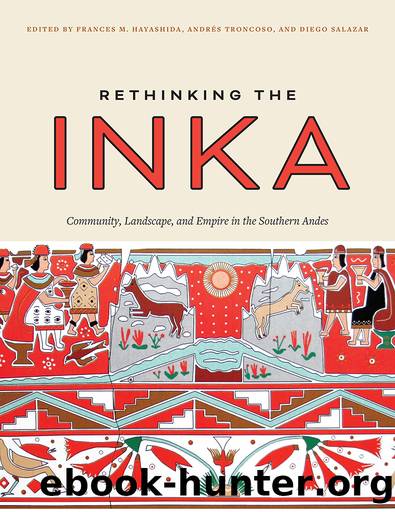Rethinking the Inka by Frances M. Hayashida

Author:Frances M. Hayashida
Language: eng
Format: epub
Publisher: University of Texas Press
Published: 2021-01-15T00:00:00+00:00
Figure 8.7. Usnu position in relation to the equinox sunrise: (a) schematic plan; (b) picture captured on March 21, 2015, from one end of the tiyana.
Figure 8.8. Solar alignments on the Western Terraced Hill: (a) aerial view, showing the corresponding sunrise dates; (b) sunrise, June 21; (c) sunrise, February 13.
A sample of more than 1,000 fragments from the Discard Zone showed that over half of the pieces presented decoration typical of Inka designs (figure 8.9; plate 12). Also, the distinctive Inka flared-rim jars commonly called arÃbalos were by far the most common of the Inka types. Almost 70 percent of these fragments could be accurately identified as jars for serving liquids, while nearly 30 percent were from plates or other similar open vessels. The high frequency of arÃbalos can be associated with the serving of chicha in the different types of ceremonies and acts of hospitality (Bray 2004). However, the striking abundance of these vessels found in the Discard Zone is directly linked to mass festivals, a form of hospitality but on a much larger scale than any other type of meeting.
Sites of Large-Scale Chicha Production
As I have shown, studies of the numbers and circulation of some types of ceramics provide data on festivals. However, the strongest evidence is found elsewhere, at several locations with notable assemblages of mortars pecked into big blocks of stone. I have studied 24 multiple mortar groups within a radius of 3 km around El Shincal. Carbon-dating and contextual analysis of the associated archaeological materials suggest that they were constructed and used at the time of the Inka (Giovannetti 2015). These mortars are homogeneous in their morphology and types of depressions, although the number of depressions per block variesâsome had more than 60, while others had no more than 15 (figure 8.10).
These mortar blocks were related to the festivals held at El Shincal, specifically the consumption of large quantities of chicha. The excavation of contexts very close to two of the most striking assemblages revealed spaces for the production of various kinds of chicha. The presence of hearths with abundant carbonized botanical macroremains and sherds (most with signs of exposure to fire) enabled me to recognize several steps involved in producing chicha. Briefly, the ground waste of fruits and seeds found in these cooking contexts suggests that the mortar assemblages were centers of beer production (for details, see Giovannetti 2015, 2017). The mortars were found not in the area of storehouses but close to natural or artificial watercourses, as large amounts of water are needed for large-scale production. These contexts of chicha manufacture also contain remains of pots, including fragments of arÃbalos probably used to ferment, transport, and serve the beverage.
The potential magnitude of chicha production is apparent when we consider that this number of blocks with a random arrangement of mortar depressions is uncommon. Considering the characteristics of the mortars (size, number, emplacement), I have calculated that up to 170 people could have worked at the same time (Giovan-netti 2017). Alcoholic beverages made from maize and algarrobo were produced to meet the demand for the events at El Shincal.
Download
This site does not store any files on its server. We only index and link to content provided by other sites. Please contact the content providers to delete copyright contents if any and email us, we'll remove relevant links or contents immediately.
| Argentina | Bolivia |
| Brazil | Chile |
| Colombia | Ecuador |
| Guyana | Paraguay |
| Peru | Suriname |
| Uruguay | Venezuela |
Cat's cradle by Kurt Vonnegut(15155)
Pimp by Iceberg Slim(14321)
4 3 2 1: A Novel by Paul Auster(12263)
Underground: A Human History of the Worlds Beneath Our Feet by Will Hunt(11997)
The Radium Girls by Kate Moore(11900)
Wiseguy by Nicholas Pileggi(5648)
Perfect Rhythm by Jae(5306)
American History Stories, Volume III (Yesterday's Classics) by Pratt Mara L(5239)
The Fire Next Time by James Baldwin(5224)
Paper Towns by Green John(5065)
Pale Blue Dot by Carl Sagan(4886)
A Higher Loyalty: Truth, Lies, and Leadership by James Comey(4822)
The Mayflower and the Pilgrims' New World by Nathaniel Philbrick(4403)
The Doomsday Machine by Daniel Ellsberg(4397)
Killers of the Flower Moon: The Osage Murders and the Birth of the FBI by David Grann(4368)
The Sympathizer by Viet Thanh Nguyen(4287)
Too Much and Not the Mood by Durga Chew-Bose(4256)
The Borden Murders by Sarah Miller(4216)
Sticky Fingers by Joe Hagan(4086)
